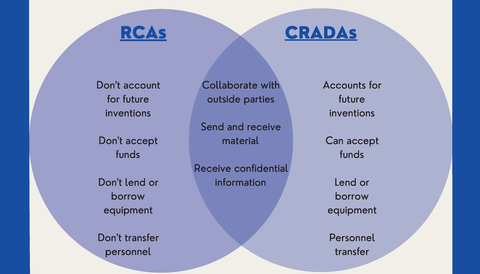
The Technology Partnerships Office (TPO) has recently developed a new type of technology transfer agreement called the research collaboration agreement (RCA).
Previously, when a NIST researcher wanted to collaborate with an external partner, from sharing research with a university to partnering with a company in the private sector, they would have to come to TPO seeking a cooperative research and development agreement (CRADA). The CRADA establishes a formal, written agreement between a federal lab and a non-federal party to allow them to work together to push research and development forward and this is done through contributions to a specific project. NIST labs, for example, can contribute to a CRADA by providing personnel, facilities, equipment, and other resources. The external party may provide the same types of contributions, and in addition, may also contribute funds for the project. Establishing and executing a CRADA can be a process and TPO knew that there were collaborative opportunities out there for NIST researchers that don’t need as many stipulations and can be streamlined.
This is where the RCA comes into play. The RCA can be thought of as similar but different to the CRADA. As the Acting Director of TPO Jeff DiVietro says, “RCAs are a great new tool we have for establishing collaborations when we don’t need all of the features that come along with a CRADA. The RCA is a much shorter agreement than a CRADA, making it faster and easier to execute, so NIST researchers and collaborators can get to the actual science and collaborative research faster.” The RCA provides the opportunity for NIST researchers and external parties to collaborate, but there are not as many actions that can be taken with an RCA, which in turn makes it easier to expedite the execution of the agreement. With an RCA, one can collaborate with outside parties, send and receive material, and can receive confidential information, but that is where the similarities between and RCAs and CRADAs end. RCAs are more limited, but quicker to application by not offering the following:
- RCAs don’t account for future inventions
- RCAs don’t accept funds
- RCAs don’t allow for lending or borrowing equipment
- RCAs don’t allow for transferring personnel
There is a benefit to utilizing this shorter agreement for a project as it helps accelerate the timetable of when NIST researchers and external parties can begin collaboration. TPO plans to continue to seek out and develop methods and mechanisms to quicken the federal technology transfer process to try and get more innovations to the commercial market to drive the economy.

